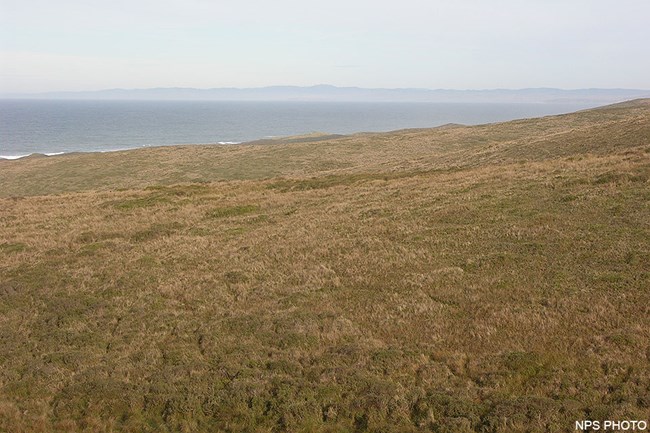
Less than one percent of California's native grassland is still intact today. The northern coastal prairie, which extends into Oregon, is the most diverse type of grassland in North America. Pristine patches of this vegetation still grow at Point Reyes on either side of the San Andreas Fault. Deschampsia coastal prairie is found on the Point Reyes peninsula and Danthonia coastal prairie is found on Bolinas Ridge. Coastal prairie is dominated by long lived perennial bunchgrasses, such as Purple needlegrass (Stipa pulchra), California fescue (Festuca californica) and California oatgrass (Danthonia californica), all of which can stay green year round with the moisture provided in the fog belt. By 1850, dairy ranchers had arrived at Point Reyes, lured by the near-ideal conditions for raising cattle. Since then, ranchers planted many non-native grasses, many of which were invasive and began to out-compete the native grasses. The most common forage plants seeded on these lands are Italian ryegrass (Lolium multiflorum) and clover (Trifolium sp.). While these are non-native species, they fortunately are not invasive. Unfortunately, invasive non-native grasses, such as Velvet grass (Holcus lanatus), Harding grass (Phalaris aquatica), and Tall fescue (Festuca arundinacea), were planted as well. The National Park Service now prohibits the planting of these invasive species in the approximately 7300 hectares (~18,000 acres) of grazing allotments within Point Reyes National Seashore and the north district of Golden Gate National Recreation Are. Since 2000, the National Park Service has been attempting to increase native seed use in these pastoral zones. Some species of native grass seed are commercially available, but it is expensive, and would not reflect the local genetic variations. The ideal conservation strategy is to collect seed from local grasses, send it to a nursery, and have it grown out on a landscape scale to create a supply for restoration projects. This has been done with California brome (Bromus carinatus) seed collected in the park which, by April 2007, had been multiplied to over 40 kilograms (900 pounds). This supply is enough to seed approximately 30 hectares (75 acres). One site at which the National Park Service is attempting to restore native grassland is the 485-hectare (1200-acre) historic D-ranch. Italian ryegrass, a non-native annual planted for forage, dominates the original homestead area today. Monitoring in this area determined that less than 5% of the vegetation was native before treatment. Two prescribed burns and native grass seeding on half of a 24-hectare (60-acre) burn unit had been completed by April 2007; but so far, not much has changed. The seed that was planted, California brome, is the most abundant native grass on the site. It has persisted throughout California, even in areas with a long history of grazing. In addition to burning the non-native ryegrass and seeding the native brome, ecologists think that mechanical treatment will also be needed to tilt the scales between ryegrass and brome. If the area is mowed after ryegrass undergoes new growth, but before it goes to seed, it will reduce competition for brome. Because the brome is a perennial, it will resprout after mowing, but the ryegrass will not. Repeated mowing in combination with burning is likely to help increase the proportion of native grass on the site. Volunteers can help the park work toward the goal of restoring native grasslands. To get involved, contact Dylan Voeller by email or at 415-464-5216. Native Grassland Restoration News - April 2007 (306 KB PDF) Learn More |
Last updated: October 7, 2023
